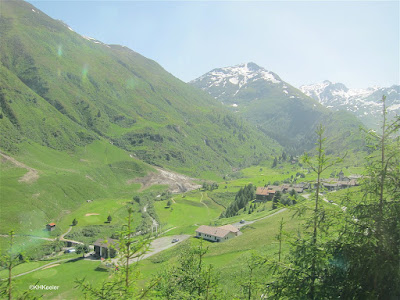Most of the people live in the central plateau, which looks more like this:
(Both photos have reflections because they were taken from train windows.)
That's an important fact about Switzerland: it is linked by a well-coordinated, efficient train system.
This train photo below makes another point: Switzerland has four national languages and says everything official in at least three of them. SBB CFF FFS are the initials of Swiss Federal Railways in German, French and Italian. The fourth language is Romansh, spoken by about 60,000 people in the large southeastern canton Grisons. In that area everything is in Romansh too.
(Generally what it means to make a language an official language of the country is that official documents must be in it, that in the courts or dealing with the government you have a right to have everything said or written in that language and of course governmental signs should be in all national languages.)
The Swiss are proud of their language diversity. They don't see multilanguage signs or package labels as a burden. People pride themselves in speaking not just all four national languages but languages of surrounding countries and English. Being in the center of Europe, with big multinationals and international organizations based in Switzerland, the languages are also very useful.
I spent a holiday in the mountains of south central Switzerland last year; this year I took a Road Scholar tour (link) to see the diversity of Switzerland.
My photographs don't do justice to changing languages and customs, which are a critical part of Switzerland. The country is a federation, each canton has local control over most every day activities. Questions from tourists such as "how many years of schooling are required?" or "are stores open on Sunday?" are answered "it depends on the canton."
We started in Zurich, north central city of about 1.5 million people in German-speaking Switzerland. Of course we saw famous buildings and bridges
but I also spotted upon this big wading bird in a neighborhood stream--not my image of a big city sight.
We went northeast to Appenzell, a town of 16,000 with historic painted buildings. I liked the brightly decorated ones
Close by was St. Gallen, a famous bishopric, with huge Catholic and protestant churches. I like attractive church architecture but St. Gallen boasts a monastery library that goes back to the early Middle Ages and about which I had heard for years. It was fascinating, however, no photos were permitted.
In Chur we admired the classical architecture, this clock tower for example
but I was distracted by the plants. Isn't this spectacular? I think the plant is the American plant, trumpet creeper, Campsis radicans (catalpa family, Bignonicaceae); at least one house in that neighborhood had trumpet creeper on the wall like this). It is deciduous, so this effect will change with the seasons.
We took the famous Glacier Express through the Alps. I have few pictures (the one at the top and the one below) because of the reflections through train windows. There were spectacular vistas.
We stopped in Brig in south central Switzerland. The view below, from the hotel...wow!
We went up ski lifts into the mountains above Brig. I took wildflower pictures but most didn't turn out well. Below is the Alpenrose, just coming into bloom. It is actually a rhododendron (Rhododendron ferrugineum, heath family Ericaceae) and makes a spectacular display when the whole bush is in bloom.
From Brig, one of course makes a side trip to the tourist city of Zermatt below the Matterhorn. No cars are allowed in Zermatt. We went by train so it didn't affect our getting there. In Zermatt, the service vehicles were all electric, and so nearly silent. Thus, despite "no cars" we had to watch carefully for traffic.
It was clear and hot (record hot June) so I got a classic Matterhorn photo:
In French-speaking Switzerland, we stopped in Lausanne, going up and down their never-level streets to see the sights
I never got closer to this urban garden, but isn't it impressive?!
Then north again, along beautiful lakes like Lake Neuchatel and through vegetable- and grape-growing country. Some of the fields were spectacularly positioned up steep slopes, but I have no photos since the train quickly passed by.
Our final stop was Basel, back in German-speaking Switzerland, a city of about 170,000 with the offices of big pharmaceutical companies and dozens of interesting museums. We were there in the record heat wave in late June 2019, so when we stood and oriented to the city from a high vantage point above the Rhine, I focused not on the wonderful buildings but those lucky people swimming in the river (on the right in the photo). People in Basel get an inflatable float, take the bus to a point upriver, get in the river and gently float down a ways, get out and take another bus home. I must try it next trip!
So I've seen some of Switzerland but not the famous buildings in Geneva or as much of the mountainous cantons or the Italian-speaking south as I'd like and I certainly have not floated down a river on a hot summer afternoon...lots more I'd like to do.
Comments and corrections welcome
Kathy Keeler, A Wandering Botanist
More at awanderingbotanist.com
Join me on Facebook: https://www.facebook.com/AWanderingBotanist

















Beautiful Post! Switzerland has been on my bucket-list since last two years. Finally, I am visiting my dream-destination with two of my friends next week on Switzerland Tourist Visa from UK. I am so excited to get there.
ReplyDelete